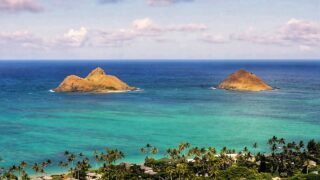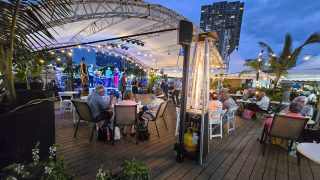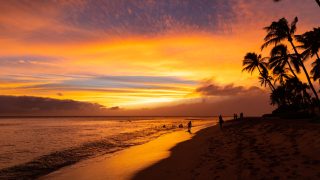While tourists pack Waikiki shoulder to shoulder, locals head just a few minutes west to Ala Moana Beach Park. From early morning walkers at Magic Island to families unloading coolers under the trees, this stretch of sand has long been Honolulu’s real gathering place. It is where residents go to swim, talk story, and find space from the crowds that never seem to leave Waikiki.
The contrast is striking. Hotels, surfboards, and selfie sticks frame Waikiki. Ala Moana is framed by palm trees, barbecue smoke, and regulars who greet each other by first name. On any given weekend, you’ll hear more pidgin than mainland accents. Aunties set up canopy tents by 7 a.m. Uncles grill teriyaki chicken at the pavilions. This isn’t a secret find for visitors. It is simply where Honolulu comes to the beach.
Locals have known the difference for decades. Informed visitors drive ten minutes from Waikiki to get there, or include the beach while shopping at Ala Moana Center across the street. But for residents, it is the natural choice. Here’s why.
What Locals Know That Tourists Miss.
Calmer water.
Ala Moana’s offshore reef breaks most of the waves before they reach shore. The result is a long, shallow lagoon that feels more like a calm bay than open ocean. It is one of the safest swimming spots on Oahu, making it ideal for kids and less confident swimmers.
Morning regulars know to arrive before the sea breeze kicks up. That is when the water turns glassy and the light catches Diamond Head perfectly in the distance.
Waikiki has its own calm sections, but they are scattered between surf zones and are always busy. Locals prefer Ala Moana’s uninterrupted stretch, where you can swim laps parallel to shore or float without dodging surfboards.
Parking that actually works.
Ask anyone who lives in Honolulu about parking at Ala Moana and they will grin. It is a ritual. The lot fills fast, but turnover is steady, and regulars know the rhythm. Weekdays before 10 a.m. are wide open. Weekends require patience, but they are nothing like Waikiki’s garage roulette and long walks in sand slippers.
Locals know which entrances to use and how to circle the outer road when the front lots are full. They even know that after sunset, the gates close, but the side exits stay open later. Ask a Waikiki hotel guest about their last parking experience and watch them wince. Parking may not sound like the soul of a beach, but for Honolulu residents, it is what keeps them coming back.
Space to breathe.
Ala Moana is big, with a mile of beach and an expansive grassy park behind it. Even on crowded weekends, there is room to spread out. Families gather for birthday parties under pavilions. Groups play volleyball near the middle section. Morning swimmers and walkers keep to their routines. It feels social without being packed.
Waikiki, by comparison, is beautiful but often overwhelming. Its narrow beaches are rimmed with seawalls and hotel chairs. At Ala Moana, locals bring their own chairs and shade tents.
Facilities that work.
The city park layout matters. Restrooms and showers are scattered along the beach, and although they are simple and in need of upgrading, they are reliable. Water fountains, picnic tables, bike paths, and lifeguard towers make it functional. For residents, that predictability matters more than fancy beachfront bars. It means families can spend the whole day without worrying about food, restrooms, parking, or safety.
Early swimmers line their slippers at the lifeguard stand, take a dip, and head to work by eight. Retirees meet for walking groups. Surfers slip out past Magic Island’s breakwall to catch small south swells. The scene changes by the hour, but the rhythm stays local and welcoming throughout the day and well into the evening.
The tradeoffs.
Ala Moana does not have Waikiki’s postcard perfection. The sand is coarser, the backdrop is urban, and the water color shifts with the tide. There are no resort amenities, no mai tais delivered to your chair, and no famous surf breaks within easy reach. Tourists expecting Waikiki glamour may leave underwhelmed.
What Ala Moana offers instead is ease. Locals do not come for the picture. They come for the comfort. It is not better than Waikiki. It is different. One is Hawaii’s global symbol. The other is Honolulu’s backyard.
How to experience it like a local.
Timing is everything. Weekdays before midmorning are peaceful. The after-work crowd arrives around five, filling the park with joggers, paddlers, and families eating dinner at picnic tables. Early Saturday mornings are full of swimmers doing their laps and triathlon groups setting out. Sundays bring the biggest local gatherings with tents, potlucks, and birthday balloons.
If you drive, enter from Ala Moana Boulevard and aim for the lots closest to Magic Island for shade and proximity to restrooms. Bring your own food and water. There are no resort concessions, only a few snack options near the mall.
Those who know the park best walk or bike in. Many live nearby and treat Ala Moana like a daily extension of home. That is what gives it its distinct local feel. It is not a destination. It is a habit.
Why residents choose Ala Moana.
Ala Moana has always balanced city and sea. Its skyline reminds you that this is Honolulu, but its calm water gives a sense of pause. Residents know that balance. They come to swim, gather, and take a break without leaving town.
Waikiki will always belong to the world. Ala Moana belongs to Honolulu. The park was dedicated in 1934 by President Franklin Delano Roosevelt and dubbed “The People’s Park.” Next time you see the Waikiki crowds, remember: Honolulu residents are already at the beach. They’re just ten minutes west.
Do you include Ala Moana Beach Park when you visit Waikiki?
Get Breaking Hawaii Travel News







So let me ask this question… how would / do the locals feel about tourists / visitors flocking to “their” beach.
Just like some surf spots are heavily localized, is Ala Moan this way?
Mahalo for letting us know which airlines offer real service when upgrading our flights. Also, great article about Ala Moana Beach. I have been there a few times and totally agree with your analysis and the comment “no mai tais delivered to your chair” was spot on. That and the long walk getting there probably kept those type of tourists in Waikiki.
Magic Island Lagoon is great.
Be aware that there is an unhoused encampment at Ala Moana on the green side.
I use to swim there but would develop bad sinus infections and only after talking with a former director of Hawaii health dept did I find out the pollution level is high there as the Ali wai canal water swings around magic island
I grew up in Honolulu and Ala Moana Beach Park was where we went to often, from when I was little until I left the islands as an adult. My favorite memory of Ala Moana was watching the sunset to the right of me and watching the lights of Waikiki turn on to the left of me, after working an 8 hour flight from Chicago. (I was a F/A and worked the Chicago to Honolulu flights and arrived into Honolulu at 3 pm.) I would go from the airport to the beach, have a swim and relax. Sure do miss those days.